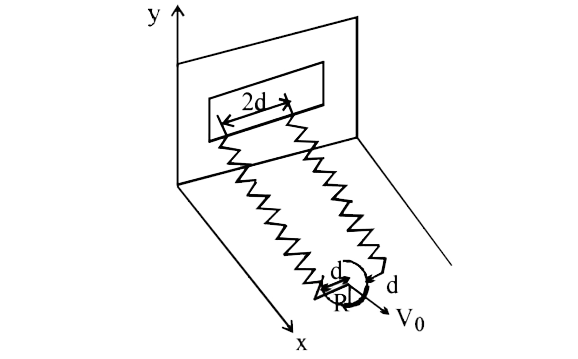The motion of a particle is represented by the function "Asin2ωt+Bcos2ωt+Csinωtcosωt".
Where x,ω amd t present displacement, angular frequency and time respectively. The constants A,B and C are related to the amplitude pf displacement. Select CORRECT alternative(s).Solution in Gujrati
for any value of A, B and C (except C=0)
If A=−B,C=2B, amplitude =∣∣B√2∣∣
If A=B,C=0
If A=B,C=2B, amplitude =|B|
The correct Answer is:A, B, D
For A=−B and C=2B
X=Bcos2ωt+Bsin2ωt=√2Bsin(2ωt+π4)
This is equation of SHM of amplitude √2B
If A=B and C=2B, then X=B+Bsin2ωt
This is also equation of SHM about the point X=B function oscillates between X=0 and X=2B with amplitude B.
Topper's Solved these Questions
- SIMPLE HARMONIC MOTIONBOOK - ALLEN CHAPTER - SIMPLE HARMONIC MOTIONEXERCISE - Paragraph
3 Videos
- SIMPLE HARMONIC MOTIONBOOK - ALLEN CHAPTER - SIMPLE HARMONIC MOTIONEXERCISE - Subjective
30 Videos
- SIMPLE HARMONIC MOTIONBOOK - ALLEN CHAPTER - SIMPLE HARMONIC MOTIONEXERCISE - Exercise-05 [B]
12 Videos
- RACEBOOK - ALLEN CHAPTER - RACEEXERCISE - Basic Maths (Wave Motion & Dopplers Effect) (Stationary waves & doppler effect, beats)
25 Videos
- TEST PAPERBOOK - ALLEN CHAPTER - TEST PAPEREXERCISE - PHYSICS
4 Videos
Similar Questions
A uniform thin cylindrical disk of mass M and radius R is attaached to two identical massless springs of spring constatn k which are fixed to the wall as shown in the figure. The springs are attached to the axle of the disk symmetrically on either side at a distance d from its centre. The axle is massless and both the springs and the axle are in horizontal plane. the unstretched length of each spring is L. The disk is initially at its equilibrium position with its centre of mass (CM) at a distance L from the wall. The disk rolls without slipping with velocity →V0=vacV0ˆi. The coefficinet of friction is μ.

The net external force acting on the disk when its centre of mass is at displacement x with respect to its equilibrium position is.
View SolutionTwo masses m1 and m2 concute a high spring of natural length l0 is compressed completely and tied by a string. This system while conving with a velocity v0 along +ve x-axis pass thorugh the origin at t=0, at this position the string sanps, Position of mass m1 at time t is given by the equation x1t=v0(A/1−cosωt). Calculate (i) position of the particle m2 as a funcation of time, (ii) l0 in terms of A.
View SolutionA particle of mass (m) is executing oscillations about the origin on the x axis. Its potential energy is V(x)=k|x|3 where k is a positive constant. If the amplitude of oscillation is a, then its time period (T) is.
View SolutionThe frequency of a radar is 780 MHz. After getting reflected from an approaching aeroplane, the apparent frequency is more than the actual frequency by 2.6 kHz. The aeroplane has a speed of
View SolutionChoose the correct statement:
View SolutionThe motion of a particle is given by x=Asinωt+Bcosωt. The motion of the particle is
View Solutionनिचे दिए गये समय के फलनों में कौन (a) सरल आवर्त गति (b) आवर्ती परन्तु सरल गति नहीं, तथा (c) अनावर्ती गति को निरूपण करते है। प्रत्येक आवर्ती गति का आवर्तकाल ज्ञात कीजिए : (ω कोई धनात्मक अचर है।)
(a) sinωt−cosωt
(b) sin3ωt
(c) 3cos(π4−2ωt)
(d) cosω+cos3ωt+cos5ωt
(e) exp (−ω2t2)
(f) 1+ωt+ω2t2
View SolutionThe displacement s of a particle at time t is given by s=αsinωt+βcosωt then acceleration at time t is
View SolutionThe particle performing S.H.M. with epoch alpha displacement of motion is x = A sin omega t + alpha . The term (omegat+alpha) is known as
View SolutionIf dispolacement x at time t is x=acosωt−bsinωt, where ω is a constant, then: acceleration=
View Solutionएक कण का विस्थापन समीकरण x=asinωt+bcosωt है। कण की गति है :
View Solutionदोलन करते हुए एक कण का विस्थापन x=asinωt+bcosωt द्वारा प्राप्त होता है जहाँ a,b नियतांक है -
दर्शाइए की कण की गति सरल आवर्त गति है।
View SolutionOut of the following functions representing motion of a particle which represents SHM :
(A) y=sinωt−cosωt
(B) y=sin3ωt
( C ) y=5cos(3π4−3ωt)
(D) y=1+ωt+ω2t2.
View Solutionनिम्न में से कौन से फलन सरल आवृति गति व्यक्त करते है।
(i) sin2ωt
(ii) sinωt+2cosωt
(iii) sinωt+cos2ωt
View SolutionThe motion of a particle is given by X=Asinωt+Bcosωt the motion of the particle is
View Solutionएक कण का समय के साथ विस्थापन-परिवर्तन निम्न संबंध के द्वारा व्यक्त होता है y=asinωt+bcosωt
View Solution
